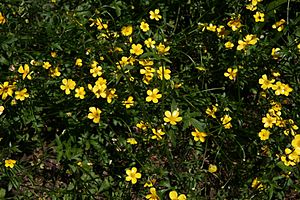Common buttercup facts for kids
Quick facts for kids Common buttercup |
|
|---|---|
 |
|
| Scientific classification | |
| Genus: |
Ranunculus
|
| Species: |
lappaceus
|
| Synonyms | |
|
Ranunculus discolor Steud. |
|
The Common Buttercup, also known as the Australian Buttercup or Yarrakalgamba, is a bright yellow flower found in eastern Australia. Its scientific name is Ranunculus lappaceus. Just like other buttercups around the world, this plant grows back every year. It shows off its cheerful yellow flowers in spring and summer.
Contents
What's in a Name?
The Common Buttercup was first described by a scientist named James Edward Smith in 1815. It still uses the same name he gave it. This plant belongs to a big group of plants called Ranunculus, which are all known as buttercups. The word "lappaceus" in its name comes from Latin and means "with burrs".
What Does It Look Like?
The Common Buttercup is a plant that lives for many years. It can grow up to 50 centimeters (about 20 inches) tall. Its flowers are bright yellow and have five petals. Each flower can be up to 4 centimeters (about 1.6 inches) wide. You can see these pretty flowers in spring and summer. When the plant grows new parts, they are often a bit hairy.
Where Does It Grow?
The Common Buttercup is found all over eastern Australia. This includes Queensland, New South Wales, Victoria, South Australia, and Tasmania. In Western Australia, you'll find a similar plant called R. colonorum. This other species has sepals (the green parts under the petals) that curve backward. Sometimes, people have confused R. colonorum with R. lappaceus.
This buttercup loves to grow in soils that hold a lot of moisture. These are often heavy soils like clay. For example, around Sydney, R. lappaceus grows in clay or alluvial soils. You can find it in open forests with trees like the mountain blue gum or forest red gum. It grows from sea level up to about 1,200 meters (about 3,900 feet) high. The areas where it grows usually get between 700 and 1,200 millimeters (about 28 to 47 inches) of rain each year.
How Climate Affects It
Scientists have studied how plants are changing because of climate. In one study in Victoria, they found something interesting about the Common Buttercup. In 2006, these buttercups flowered 78 days earlier than they did in 1983. This change suggests that the climate might be affecting when plants bloom.
Growing Your Own Buttercup
The Common Buttercup is quite easy to grow in gardens. It likes soils that are a bit acidic. You can plant it in a spot that gets full sun or a little bit of shade. It looks great in rock gardens or as part of general flower beds.
See also
 In Spanish: Botón de oro común para niños
In Spanish: Botón de oro común para niños

